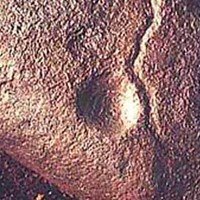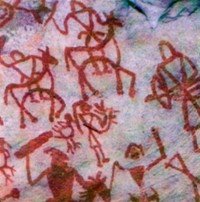Bhimbetka Petroglyphs
Acheulian Cupule art, Madhya Pradesh, India.
MAIN A-Z
INDEX - A-Z of PREHISTORIC ART
|
Bhimbetka Petroglyphs |
|
|
 Cupule and meander petroglyph on a boulder at the Auditorium Cave, Bhimbetka, Madhya Pradesh, India (c.290,000-700,000 BCE). The world's Oldest Art. |
Bhimbetka Petroglyphs (290,000-700,000
BCE)
|
 Rock Art from Bhimbetka - 7000 BCE Created over 250,000 years after the first petroglyphs and cupules were produced at the Auditorium Cave. See also Prehistoric Art Timeline. |
|
OLDEST PREHISTORIC
CARVING PREHISTORIC ART
in IRELAND |
What are Petroglyphs? - A Definition The term "petroglyph" stems from two Greek words ("petros" meaning rock, and "glyphein" meaning to carve) and means simply "rock carving." Location The two prehistoric caves where the world's earliest art was found, are located in the Madhya Pradesh region of central India. Thus at present it seems that the art of India is considerably older than African art, hitherto assumed to comprise the earliest artistic tradition. The quartzite rock formations at Bhimbetka number over 700 rock shelters, over 500 with cave murals and other forms of paleoart. Archeological excavations began back in the early 1970s and nearly a dozen shelters were investigated. Auditorium Cave, Bhimbetka Auditorium Cave comprises a large horizontal tunnel roughly 25 metres long leading to a cavernous high-ceilinged chamber with three passageway exits: the whole cave gallery resembling a cross whose centre is marked by a huge rock some nine cubic metres in size, named "Chief's Rock." Within the Auditorium cave complex, archeologists have found eleven petroglyphs. Nine cupules (cup-shape hollows) were first discovered in a large vertical boulder face above ground level. A little later, a tenth cupule along with a single meandering groove, indisputably associated with it, were found covered by remains dating from the Acheulian period. These petroglyphs were created on heavily recrystallized, very hard quartzite that was extensively mined during the Lower Palaeolithic. The majority of Acheulian chopping tools (hand axes, cleavers) found at the site are made from it. The petroglyphs were located in a weatherproof section in the heart of the cave, but significant corrosion had taken place due to their exceptional antiquity. The coincidence of the two buried petroglyphs and the nine above ground cupules suggests that all were created at the same time, and this was confirmed by micro-erosion tests. While no radiometric dating information is available from the Auditorium cave site, the Acheulian culture of India is comparable with that of Africa and Europe, and all radiometric dates so far for such cultural relics have been greater than 290,000 years. In India, the Later Acheulian dates to roughly 500,000-700,000 BCE and the Final Acheulian to roughly 200,000 BCE. Thus the Bhimbetka petroglyphs would fall at least within this range and possibly some will prove to have been created during the Early or Middle Acheulian (that is, before 700,000 BCE). Daraki-Chattan Rock Shelter At a second Stone Age site at Daraki-Chattan, a small, narrow and deep cave in the Indragarh Hill, near Tehsil Bhanpura, Madhya Pradesh, archeologists found two vertical panels densely pitted with 498 cupules dating from a Lower Palaeolithic chopping tool culture. A quantity of hammerstones used to create these cupules were also recovered. Excavations of local river sediment indicated a date range of between 400,000 to 1.8 million years BCE. The discovery of this second ancient cave (like the unearthing of the Venus of Tan-Tan after the original discovery of the Venus of Berekhat Ram) tends to validate the Lower Paleolithic provenance of the Auditorium cave. Although the age of Daraki-Chattan's rock art still has to be determined, archeological evidence at the site tentatively suggests that it is contemporaneous with the cupules at Bhimbetka cave. A similar tentative conclusion has been reached regarding rock carvings discovered on boulders in two further caves of the region, at Bajanabhat 1 and 2 in Rajasthan. See also: Oldest Stone Age Art: Top 100 Works. Early Indian Petroglyphs (EIP) Project Note that much of the investigation into the ancient art of these caves has been performed under the auspices of the Early Indian Petroglyphs (EIP) Project. Initiated by Robert G. Bednarik and G Kumara the EIP is a collaboration between the Rock Society of India, Agra (RASI) and the Australian Rock Art Research Association (AURA), supported by the Archaeological Survey of India (ASI) and the Indian Council of Historical Research (ICHR). Indeed, major excavations were started at Bhimbetka and Daraki-Chattan in 2002, resulting in further finds of petroglyphs, cupules and Lower Paleolithic tools (eg. hammer stones) which are still being investigated. Note: For facts about other forms of parietal art, see cave painting, especially the cave murals at Chauvet (c.30,000 BCE), Pech-Merle (c.25,000 BCE), Cosquer (c.25,000 BCE), Lascaux (c.17,000 BCE) and Altamira (c.15,000 BCE). Dating of Bhimbetka and Daraki-Chattan The claims of longevity regarding the Bhimbetka petroglyphs have been solidly validated by archaeological evidence from Daraki-Chattan, establishing their minimum age at several hundred millennia BCE. According to Robert G. Bednarik, there is no reasonable doubt that some or all of the petroglyphs at the Auditorium cave, were created by people of a Lower Palaeolithic tool culture characterized by hand choppers, like those belonging to the African Oldowan culture, and therefore pre-dating the Acheulian, which began in India around 1.6 million BCE. He makes the point, however, that there is not at present sufficient scientific research into the earliest reaches of the Lower Paleolithic era in India (2,000,000 - 1,000,000 BCE) to determine the precise antiquity of these extraordinary finds. Even so, the Bhimbetka cupules are easily the most ancient Asian art ever found. Note 1: For details of similar petroglyphs, comprising the oldest rock art of Europe, see: La Ferrassie Cave Cupules. Note 2: For information about prehistoric sculpture, in ivory and terracotta as well as rock, see: Venus Figurines and the Ivory Carvings of the Swabian Jura (c.33,000 BCE), in Germany. Note 3: Madhya Pradesh is also home to many other cultural treasures, such as the UNESCO World Heritage Site of Kandariya Mahadeva Hindu Temple at Khajuraho (1017-29). See also Classical Indian Painting (Up to 1150 CE) and Indian Sculpture (3300 BCE - 1850), as well as Mughal painting and Mughal architecture, see for instance the Taj Mahal (1632-54) in Uttar Pradesh. |
|
• For more about the arts and crafts of ancient India, see: Homepage. ENCYCLOPEDIA OF STONE AGE ART |